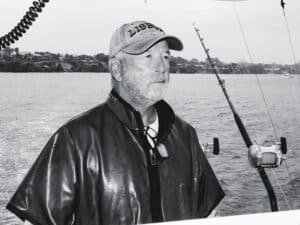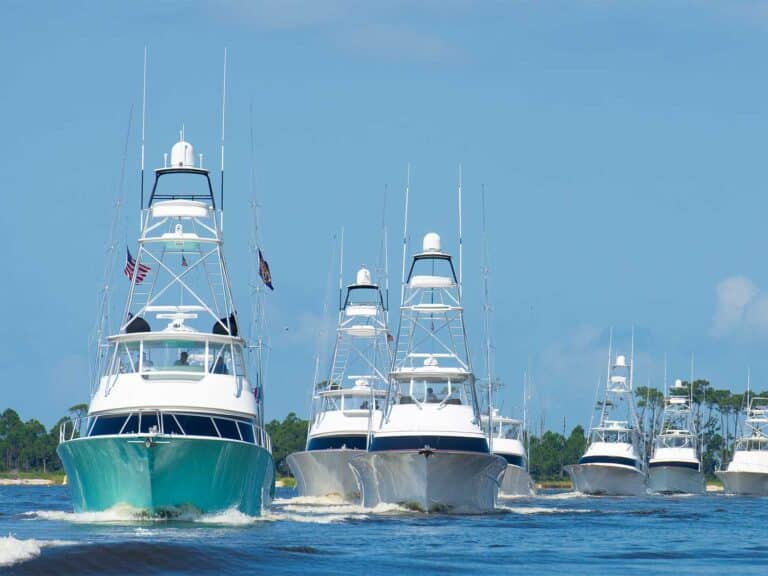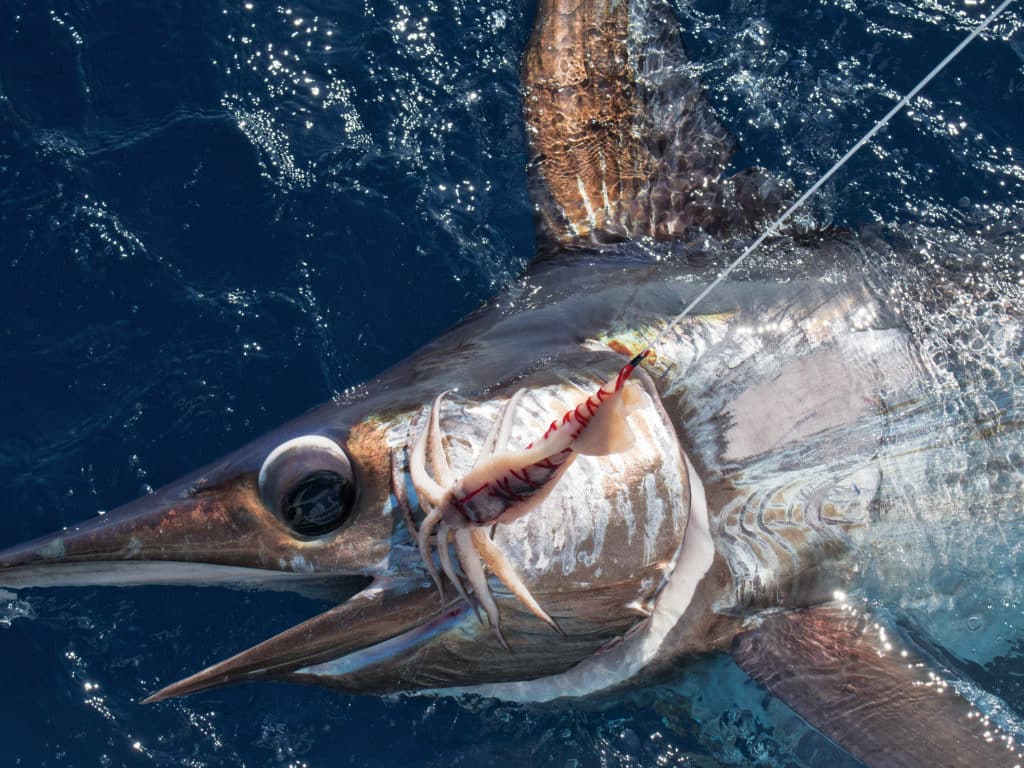
As he had done hundreds, if not thousands, of times while swordfish fishing, Capt. Brett Holden sent down a squid on a 50-wide reel and said, “I bet we get bit in less than 30 seconds.” The weight hit the bottom, and as soon as he cranked the bait off the bottom, the highly anticipated tap-tap of a swordfish whacking the bait was already there. He teased the fish with a series of drop-backs and quick cranks, and the rod tip nearly hit the water when it bent under the load as the fish was hooked.
Holden yelled, “We’re tight!” and I thought to myself, You’ve got to be kidding me. I grabbed the rod and clipped into the stand-up harness for the fight that often comes with swordfish fishing. At the same time, Matt Reed, the mate on Booby Trap, sent down a second bait. As soon as I started to crank on my fish, the second rod was bent over with a doubleheader. Landing both of them in relative short order made us 18 fish shy of Holden’s quest for 1,000 swordfish, the reason for my trip.
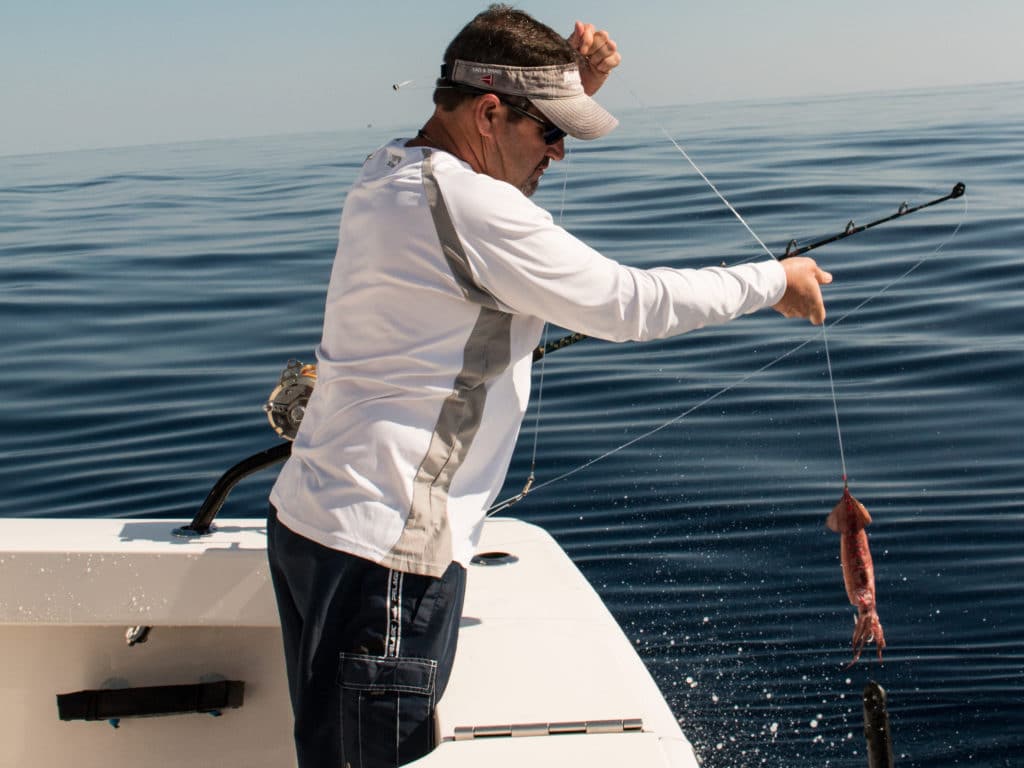
Direct-Dropping for Swordfish
A Deserving Name
The weeks leading up to my trip to Freeport, Texas, to fish aboard Booby Trap were a waiting game; I kept a bag packed, ready to depart at a moment’s notice in case a weather window opened during the unpredictable late-spring months in the western Gulf of Mexico. Nightly conversations about ever-changing wind models with Holden, known as “Captain Ahab” in the swordfishing community, led to further discussions about his fascination with swordfish and his countless days spent on the water deciphering their movement patterns and diet, and learning how to target them. To say he is obsessed with broadbill swordfish would be an understatement; his life revolves around these prehistoric fish.
Swordfish, or Xiphias gladius, deserve every bit of their gladiator namesake. “We’ve caught every big fish in the Gulf of Mexico, from bluefin tuna to blue marlin,” says Holden, “and there is no doubt swordfish are the most powerful fish in the ocean. Not only do they continue to fight after hours of battle, when other fish would die or give up, but they are also the toughest to catch. Imagine trying to catch a fickle white marlin a quarter-mile below you: That’s a swordfish.”
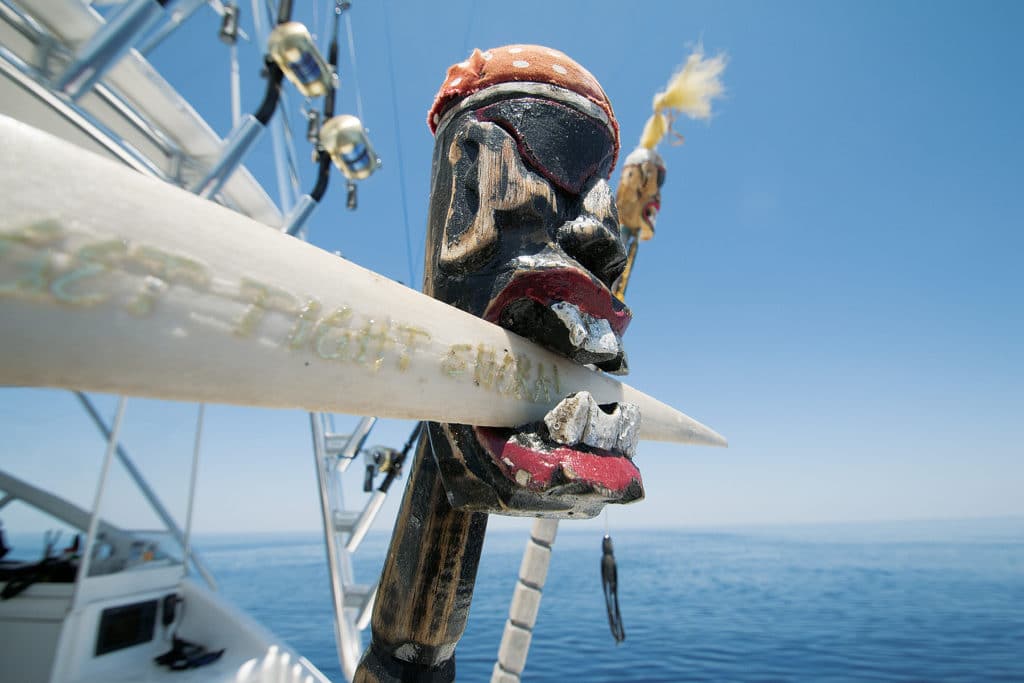
Holden started fishing for swordfish in the 1980s, and as he told his stories, it was apparent that his success was not instantaneous. At the time, no one thought swordfish, believed to be fished out of existence by a commercial longline fleet, could be caught on a regular basis. Never one to turn down a challenge, Holden was determined to catch one and competed against dock mate Bill Thurber to see who could catch the first swordfish.
Each took between 15 and 20 trips before Thurber showed up at the marina one morning holding a 15-pound swordfish, thereby winning the friendly bet. They took the next trip together and caught five, fueling Holden’s fascination and desire to catch more. During his first year, Holden caught 28 swordfish, and during the next several years, he spent countless nights in the Gulf chasing them.
Holden became truly hooked on chasing large swordfish in 1993, when he fought a nighttime swordfish for more than 11 hours before the fish nearly spooled a 50-wide and he was forced to break it off. “The best thing about swordfishing is the fact that you never know what size fish you are going to hook. It could be a 20-pounder or one weighing over 1,000 pounds,” says Holden.
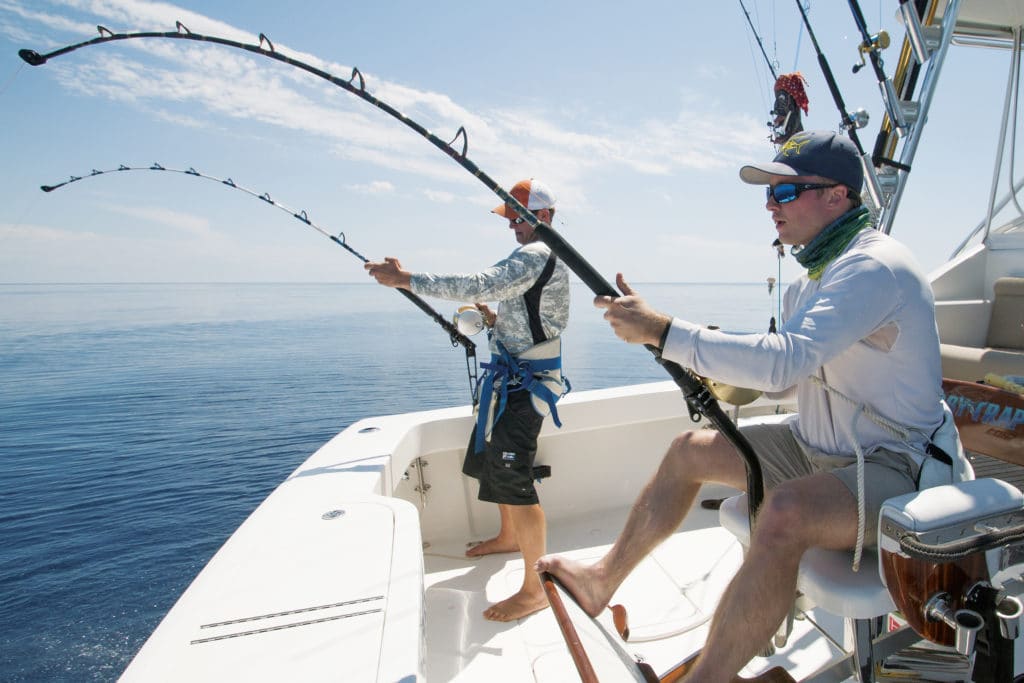
Chasing Giants
With no real size to the typical 20- to 70-pounders caught during the night, Holden began experimenting with Texas daytime swordfishing in 2008 after learning of success with larger fish from the guys in Florida. With no luck, he packed his 52-foot Viking express and headed for South Florida in 2009. Learning from several locals, Holden caught numerous daytime swordfish and even had a six-fish day, one short of the record set by Capt. Nick Stanczyk. Determined to catch a swordfish over 500 pounds, Holden told his wife he wouldn’t be home until he accomplished the feat. Three weeks after arriving in Florida, he landed one around 650 pounds.
With visions of large swordfish in my head and Holden just 23 fish away from 1,000, we had the makings of an incredible trip. The day I departed, Holden sent me a photo of Stanczyk with his elbow on a 20-pound bag of ice from their record-setting trip of 30 swords in three days. During that trip, they caught 23 fish over 200 pounds, had 12 doubleheaders and set a daily record of 15 fish. The accompanying text read, “Be ready to reel. GET TIGHT SUCKA!”
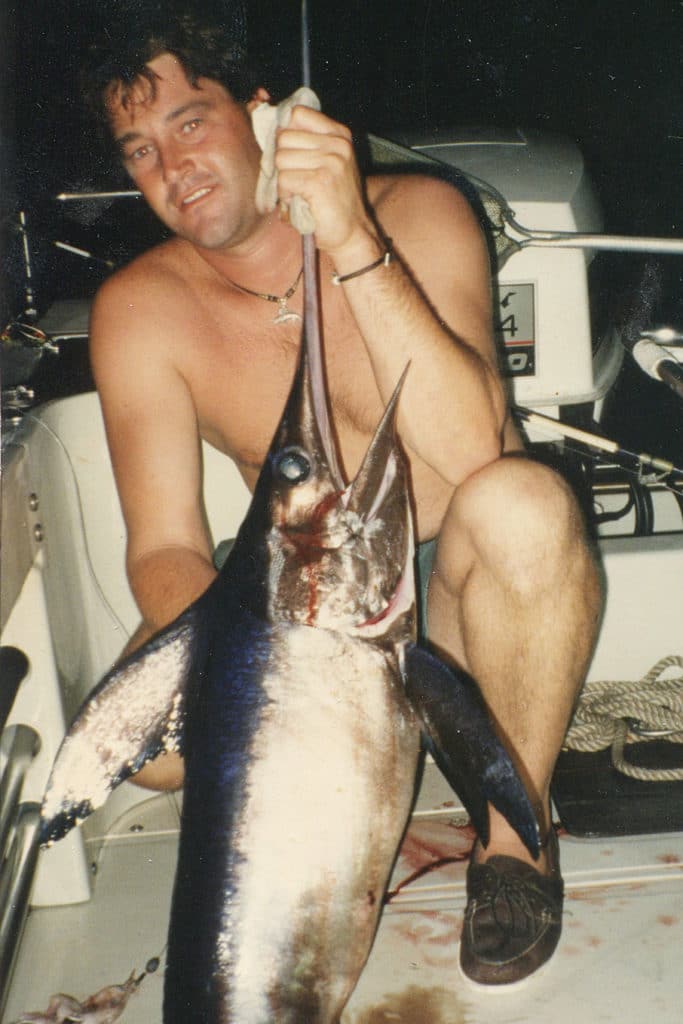
On the way out to the fishing grounds, roughly 85 miles from Freeport, we studied the bottom features we would fish during the next couple of days. “Compared to guys who target particular contour lines, we target bottom features depending on bait movement and current,” Holden said. “When we find the bait stacked up, there is a pretty good chance we will get multiple fish. Working walls, ledges and canyons in depths of 1,600 to 1,800 feet, what appears to be a small change in depth on the sounder is actually a change of over 100 feet. More often than not, we can actually see individual fish on the bottom and drop directly down to them.”
Over the years, Holden and his crew have shifted their focus away from the numbers and have begun targeting larger fish, what they call the “thunder bite.” Holden says, “A lot of the big ones are rogue fish and are often up in the water column. Honestly, that is why a lot of people get lucky and come home with one very large fish rather than getting the numbers. Our biggest fish were caught in the middle of canyons while bump-trolling baits 300 to 500 feet off the bottom. Large swordfish are smart, and they’ve probably eaten 5 million squid in their life, so things need to look like something they’ve eaten before. It’s tough because they like a moving bait, and you are teasing the fish a quarter- to a half-mile away depending on the scope in the line.”
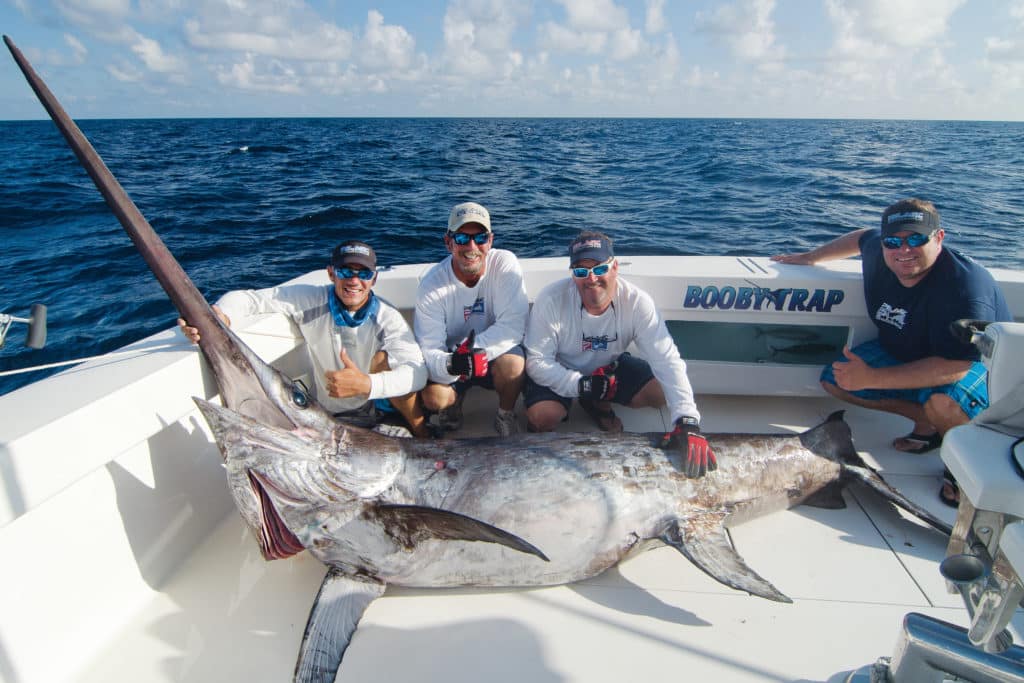
Organized Crew
I watched as Holden and his counterpart, Capt. Jeff Wilson, meticulously worked a deep hole. Slowly working down one side, through the bottom and up the other side, they constantly rechecked the bottom to make sure the bait was moving through the zone. Compared with Florida, where the current is strong on the surface and at depths, the western Gulf lacks this consistent challenge when trying to get to depths of over 1,500 feet. This enabled Holden to perfect his direct-drop method (see sidebar), allowing him to pinpoint the location where he wants the bait to go and drop a second bait for a chance at a doubleheader.
> “We’ve changed to almost exclusively using conventional fishing gear out of respect for the fish. I wish everyone would switch back to using conventional gear. We are one of the largest supporters of Lindgren-Pitman, but a Reel Crankie and a good drill can be faster than an LP.”
The team uses a 50-wide Shimano Talica or Tiagra matched with Holden’s Get Tight Sucka (GTS) rods. “We’ve changed to almost exclusively using conventional fishing gear out of respect for the fish,” Holden says. “I wish everyone would switch back to using conventional gear. We are one of the largest supporters of Lindgren-Pitman, but a Reel Crankie and a good drill can be faster than an LP.” At this point, the team only uses electric reels when the bite is slow to bump-troll and cover large areas quickly. However, once Holden finds the bite, everything is back to conventional.
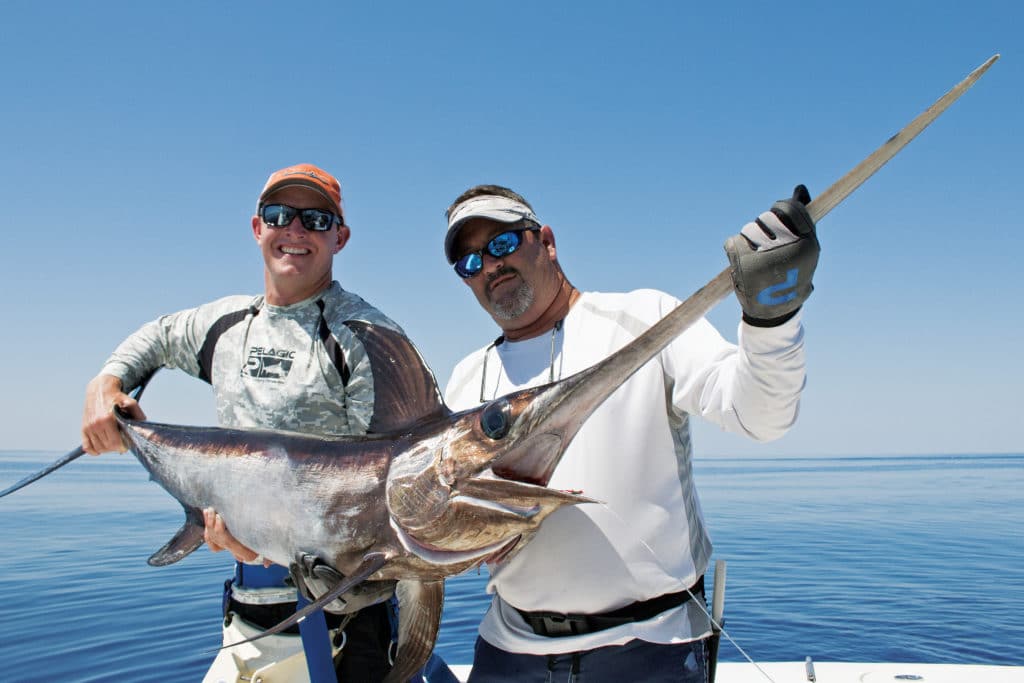
Match the Hatch
Catching four fish the first day, we inspected the stomach contents of the two fish we kept. Holden explained that the size of the bait dictates what the fish are more likely to attack, and the size of the prey in their stomach directly relates to how likely they are to be hooked. “Early in summer, when they are feeding on 4- to 6-inch squid, they are having to eat a bunch of them to fill up and burning a lot of energy in the process,” he said. “However, when the larger squid come inshore later in summer and we find half of a 50-pound squid in the stomach of a sword, they are less likely to eat our baits. Instead, those fish are snagged from whacking at the bait instead of eating it.”
Over the course of the three-day trip, we hooked three doubleheaders and finished 11 for 14, falling short of the 23 fish we needed to reach 1,000 swordfish overall. We released a doubleheader of 250-pound-class fish followed by a 400-pound-plus fish that we only got a quick look at before it popped off the leader. With the legal limit of just four swordfish per trip, Holden and his crew can’t take home every swordfish they catch, an unimaginable thing for many anglers. Holden estimates they release more than 80 percent of their swordfish, only taking home those that are hooked in the throat and have a slim chance of surviving. In 2013 alone, they released 13 swords that would have topped the 343-pound unrestricted Texas state record they set in 2010. Later that year, they broke the conventional record with a 493-pounder, the current Texas and Gulf of Mexico record.
After the trip, I asked Holden about his most memorable fish. He recounted a fish the crew fought for 23 hours, only to pull the hook. “We were after a junior world record with my nephew, and when that fish struck the bait, we knew we had a big one,” he said. “It whacked at the bait seven times before we hooked it.” Coming tight at 1 o’clock in the afternoon, the junior angler fought the fish for 18 hours before he was relieved; the fight continued until noon the following day, when the fish made one last 1,000-yard run before pulling the hook. When it was all said and done, the fish had pulled them a total of 18 miles.
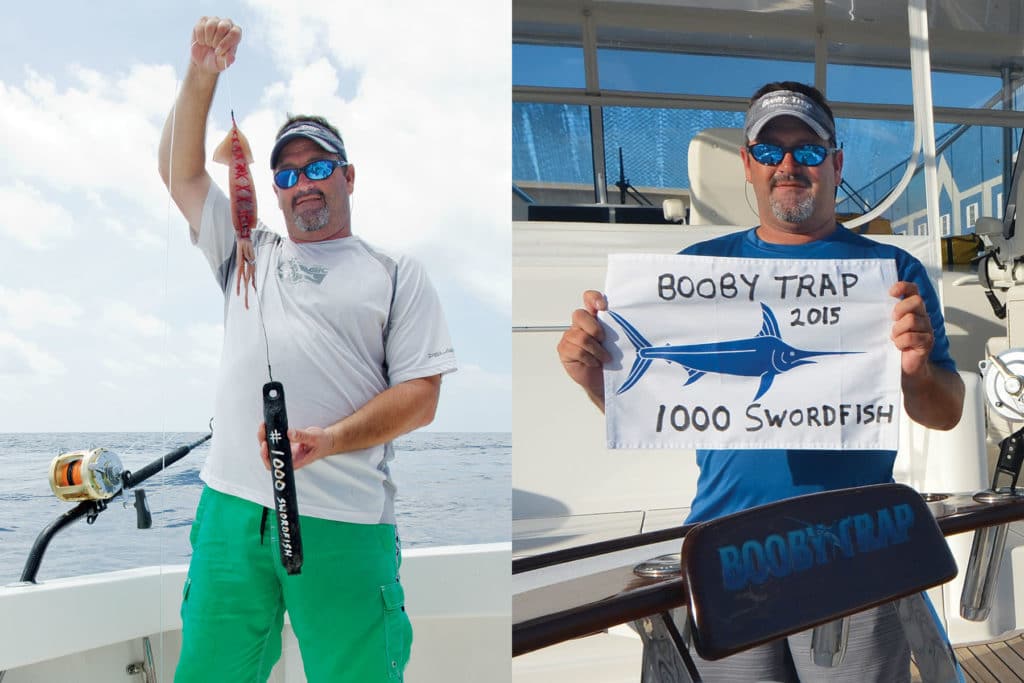
Mission Accomplished
I got the call on a Tuesday morning in late July. “We got them, and we’re currently at 1,001,” Holden said. “It was a tough trip, but we got it done.” He rehashed many of his great seasons and trips as he once again tallied the numbers in his head. “You can cheat in golf, you can cheat in poker, but you can’t cheat in fishing,” he proclaimed. The journey for 1,000 was never the goal in the beginning, but after tallying the logbooks, Holden and crew realized how close they were coming to their now completed milestone.
During his 28 years of fishing for swordfish, Holden feels he made a name for himself with one of the most challenging fish in the ocean. “With the rest of the billfish, anyone with a $500 plane ticket and a charter boat can go after them, but that’s not always true for swordfish,” he said. “There are only a few places people catch them, and there aren’t that many people who can consistently put you on a daytime swordfish. It’s such a challenge, and that’s why I like it.” Who can say they are the best at one thing? Holden and crew have set the record to prove it, and I think it is safe to say they are just that.



